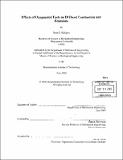| dc.contributor.advisor | John B. Heywood. | en_US |
| dc.contributor.author | Hallgren, Brian E. (Brian Eric), 1976- | en_US |
| dc.contributor.other | Massachusetts Institute of Technology. Dept. of Mechanical Engineering. | en_US |
| dc.date.accessioned | 2005-08-24T19:17:10Z | |
| dc.date.available | 2005-08-24T19:17:10Z | |
| dc.date.copyright | 2000 | en_US |
| dc.date.issued | 2000 | en_US |
| dc.identifier.uri | http://hdl.handle.net/1721.1/9053 | |
| dc.description | Thesis (S.M.)--Massachusetts Institute of Technology, Dept. of Mechanical Engineering, 2000. | en_US |
| dc.description | Includes bibliographical references (p. 135-139). | en_US |
| dc.description.abstract | Emissions from compression ignition (CI) engines are being placed under stricter regulations. The use of oxygenated fuels has been proposed as a means of complying with future emission levels. Previous research on oxygenates has suggested the presence of molecular oxygen within the fuel significantly reduces the formation of particulate matter (PM). The PM reduction is logarithmic and correlates with the weight percent of oxygen in the fuel and not with other properties such as chemical structure and volatility. However, many studies fail to correctly decouple the effects of oxygenates from other fuel properties that impact emission levels; such as cetane number, density, aromatic content, and volatility. Mechanisms responsible for changes in the combustion process and emissions were investigated with a matrix containing 14 fuels, addressing oxygenate proportionality, structure, volatility, equivalent structure without oxygen, and changes in the base diesel fuel. A scanning mobility particle sizer (SMPS) was used to evaluate changes in particle size distributions, in addition to gravimetric filter and oxides of nitrogen (NOx) measurements. Engine emissions tests were conducted using a Ricardo Hydra MK IV direct injection (DI) diesel engine. The sensitivity of engine operation parameters to intake temperature, load, injection timing, and ignition delay (ID) were evaluated with the baseline fuel. All fuels in the matrix were matched for total released energy and combustion phasing, using a cetane improving additive. The changes in emission have been quantified with agreement between the relative trends observed with the integrated SMPS volume concentrations and filter measurements. In order to evaluate changes among fuels and measurements taken with the SMPS, various fuels were subjected to physical and chemical characterization in order to determine morphological and compositional changes. | en_US |
| dc.description.statementofresponsibility | by Brian E. Hallgren. | en_US |
| dc.format.extent | 144 p. | en_US |
| dc.format.extent | 10216056 bytes | |
| dc.format.extent | 10215814 bytes | |
| dc.format.mimetype | application/pdf | |
| dc.format.mimetype | application/pdf | |
| dc.language.iso | eng | en_US |
| dc.publisher | Massachusetts Institute of Technology | en_US |
| dc.rights | M.I.T. theses are protected by copyright. They may be viewed from this source for any purpose, but reproduction or distribution in any format is prohibited without written permission. See provided URL for inquiries about permission. | en_US |
| dc.rights.uri | http://dspace.mit.edu/handle/1721.1/7582 | |
| dc.subject | Mechanical Engineering. | en_US |
| dc.title | Effects of oxygenated fuels on DI diesel combustion and emissions | en_US |
| dc.title.alternative | Effects of oxygenated fuels on direct injection diesel combustion and emissions | en_US |
| dc.type | Thesis | en_US |
| dc.description.degree | S.M. | en_US |
| dc.contributor.department | Massachusetts Institute of Technology. Department of Mechanical Engineering | |
| dc.identifier.oclc | 46052727 | en_US |
